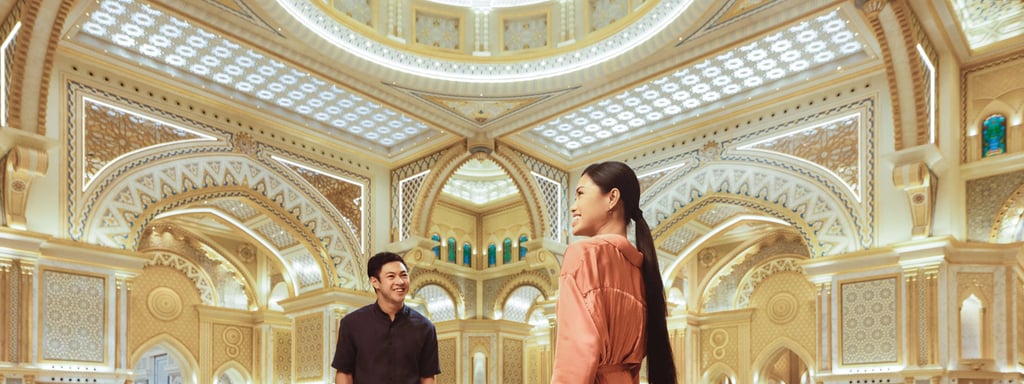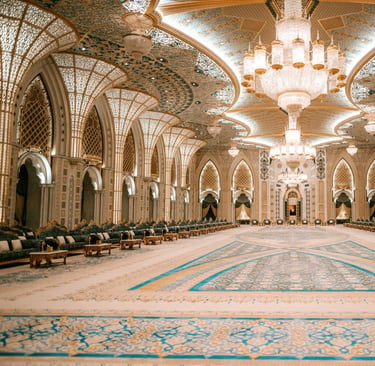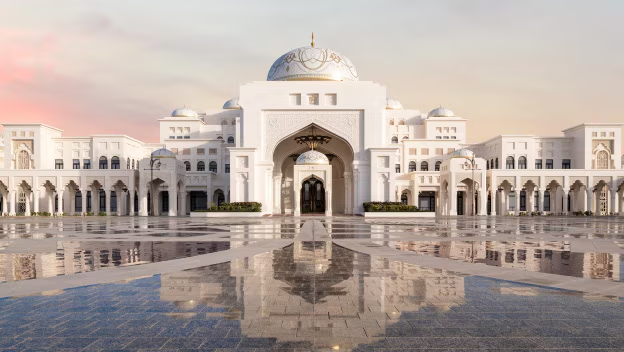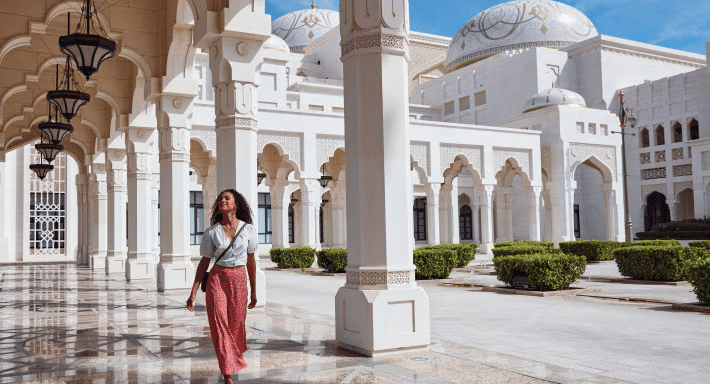Qasr Al Watan
A Palace of Wisdom Echoing Through Marble and Memory


The Majesty Awakens at the Threshold
As dawn’s pink hues drape over the domed skyline of Abu Dhabi, Qasr Al Watan emerges — a sculptural marvel of ivory marble and Islamic architecture, poised like an ancient manuscript written in stone. The palace stands, not merely as a seat of governance but as an eloquent storybook, where portals and corridors whisper allegories of statecraft, culture, and national destiny. Its grandeur is not ostentation; it is architectural storytelling—an open book inviting curious souls to ponder the interplay of power, knowledge, and identity.
Beyond the golden gates, polished courtyards reflect the sky, as if the Earth itself pauses to admire the heavens. A visitor stepping across the threshold enters a living parable of leadership and legacy, harmonizing the weight of tradition with the promise of vision. Qasr Al Watan is architecture woven from purpose, where every arch, every column, and every dome carries an elegiac sonnet of national narrative.
A Garden of Pillars and Portals
The heart of the palace is defined by expansive colonnades and emblematic courtyards, where Tuscan arches hold up the heavens in stoic rows of marble. Walkways curve gracefully toward grand halls, each chamber a stanza in the poem of governance and international cooperation. Pillars rise like silent custodians of history, their carved capitals inscribed with crescents and stars—as if to remind visitors that this place, while modern, is rooted in centuries of local tradition.
Sunlight weaves patterns of shadow across the marble floors, creating dynamic tapestries that shift with the passing hours. The effect is twofold: solemnity and serenity. Even in grandeur, visitors feel invited into contemplation. The palace is not merely seen—it is felt, in the hushed echoes of footsteps and the soft ease of breath.
The Great Hall: Where Vision Becomes Voice
At the core lies the Great Hall—a vast chamber beneath a dome that speaks of infinity. The space opens upward in a perfect curve, with geometric patterns and filigree that coax light down, as if a physical rendering of wisdom raining upon assembly. It is here that leaders gather, global dialogues convene, and policy takes shape. The acoustics are such that a whisper traveling across the marble may still be heard at the far end, symbolic of transparency and accountability.
Inlaid mosaic work rings the floor in circular motifs, suggesting dialogue and convergence, while the chandelier, composed of crystalline brilliance, evokes unity across diversity. It is a stage where diplomacy and destiny meet—all under a roof that seems to chant: "Be worthy of this trust."


The Library of Legacy
Adjacent to the Great Hall lies the library, a sanctuary of intellect laid in warm tones, where wooden shelves cradle volumes of political philosophy, Arab history, law, diplomacy, and culture. It is here that scholars and staff alike gather to explore manuscripts that illuminate the evolution of governance from both Eastern and Western traditions. Leather-bound tomes lie next to modern research journals and digital archives—a bridge between enduring wisdom and contemporary thought.
Quiet alcoves under stained glass windows offer spaces for reflection, study, and dialogue. Visitors seeking depth find themselves surrounded by the hushed pulse of pages turning, pens writing, minds dancing with questions of statehood and societies. It is a reminder that craft of leadership is not built solely on marble, but on curiosity, knowledge, and humility before complexity.
The Presidential Gifts Room: A Gallery of Global Trust
Wandering deeper, one reaches the gallery of state gifts—an extraordinary collection of objects from world leaders symbolizing respect, friendship, and diplomacy. Delicate tapestries from Europe hang alongside rare ceramics from East Asia; silverware from royal houses glimmers alongside tribal craftsmanship from Africa and the Americas. Each piece carries its own story: a moment of recognition, a shared ideal, a gesture toward cooperation.
The room is hushed. Viewed together, the gifts compose a visual mosaic of global goodwill, reminding visitors that diplomacy operates in symbols as much as treaties. And while each gift is unique, collectively they tell a story of Abu Dhabi’s quiet but profound reach in cultivating respectful dialogue.
Ceilings That Speak
The vaulted ceilings of Qasr Al Watan are not silent stone; they are murals of poetry. Intricate muqarnas waterfall above, composed of geometric and floral forms cascading in layers of plaster, gilt, and color. Between these patterns, verses of classical Arabic poetry, diplomatic axiom, and Emirati proverbs curve along borders—scripted reminders of purpose, perseverance, and progress.
Looking upward, one sees not decoration alone, but intention. The artistry of dome and cornice is a visual lesson in balance: tradition and innovation merging; geometry and nature interweaving; politics and poetry coexisting. Visitors often feel their heads tipped back as if in prayer, not solely to some external entity but to the shared purpose of humankind.


Hallways of Heritage
Beyond formal chambers lie corridors of memory. Portraits line walls during certain paths—leaders past and present, scholar elites, ambassadors whose hands once shook across tables in service of peace. The layout is non-linear, allowing for quiet detours. Floor-level inscriptions mark milestones—founding dates of institutions, landmark treaties, collaborative moments between nations—all set into travertine walkways.
Each floor blends Emirati heritage—such as palm frond lattices, sand-blown finishes, and Bedouin patterns—with global design, mirroring the country’s own zeroing in on roots while opening the world.
Gardens of Light and Reflection
Even within the palace’s stone heart pulses garden life. Courtyards bloom with bougainvillea and date palms, arranged around shimmering reflecting pools. These serene spaces offer glycol frames for contemplation, where visitors rest between chambers, savoring the interplay of shade and sun. These gardens aren’t mere landscapes—they are pauses in narrative, where the human spirit is given room to breathe.
Benches flank fountains that whisper, birds hover on branches shaped by wind, and corridors open onto plazas framed by elegant colonnades—all echoing the idea that governance requires attention to both public stage and private heart.
Voices of Diplomacy
Qasr Al Watan is not only a palace carved in stone—it is a stage for performance, negotiation, and cultural exchange. Ceremonies of statehood take place here: treaty signings, investiture festivities, diplomatic banquets beneath crystal chandeliers. Each event is choreographed to honor guests and the gravity of state obligations.
Guests from around the world pass through layered vestibules and cross guarded thresholds, their footsteps filling the hallways with a sense of process. For them, architecture amplifies importance. For visitors, the palace becomes a living arena where values are enacted through space and ritual as much as words and deeds.
Cultural Encounters and Ceremonial Rhythms
Beyond statecraft, Qasr Al Watan hosts cultural events. Concerts of classical music fill its halls, while poetry evenings and heritage festivals bring traditional Emirati culture to life. Workshops for children teach Arabic calligraphy and Emirati crafts. Exhibitions emerge to explore regional literature, ecological diplomacy, or Gulf architectural heritage.
On weekends and evenings, families wander botanical pathways that thread between domed patios and lawns. Shaded labyrinths reveal artistic installations or light shows—playful but solemn reminders that culture is not static, rather an evolving interplay between history and innovation.
Light and Marble as Mourning and Memory
The evening brings a transformation. LED pools shimmer beneath footlights. The white marble softens to golden hue. Shadows deepen. The palace does not rest—it enters a new mode. Visitors may begin with sunlight and leave wrapped in starlight, a brief pilgrimage from day to night. It is a lesson in impermanence and transition, symbolic of the responsibilities vested in leadership.
Evening tours explore how the palace was built, the philosophies it embodies, and the artisans who crafted scrollwork and tile. Light becomes a storyteller, caressing domes and columns as if highlighting the chapters of an ongoing national myth.
Craftsmen’s Legacy
The narrative of Qasr Al Watan is not written solely in leadership, but in labor—the labor of stone carvers, calligraphers, masons, glassblowers, and lighting designers. Their craft is embedded in walls, ceilings, doors, and portals. High-definition video kiosks offer behind-the-scenes glimpses, presenting artisans using age-old techniques and digital precision alike.
Wanderers learn how craftsmen trained in Italy in marble micro-carving, how sound engineers sculpted the Great Hall's acoustics, how mosaic artists in Turkey embedded zircon and glass tesserae. In these stories, the palace truly becomes a living interplay of heritage and innovation.


Practical Information
Qasr Al Watan is located on King Saud Street, Abu Dhabi. Visitors may arrive via personal vehicle or ride-sharing services; ample parking is available. Public buses stop nearby, and guided shuttles connect with Saadiyat Island attractions.
It opens daily except for official events, typically between 10:00 AM and 8:00 PM. Special programming may modify hours, especially in Ramadan or national holidays. Admission fees apply for palace grounds and exhibitions; residents and adolescents may receive discounted access. Guided tours depart regularly, with audio guides available in major languages.
Photography is allowed in most areas; tripods are permitted in non-official halls. Dress modestly. Plan to spend between two and three hours exploring public halls, domes, gardens, and exhibits. Café facilities are operational throughout opening hours.
Official website: https://qasralwatan.ae






